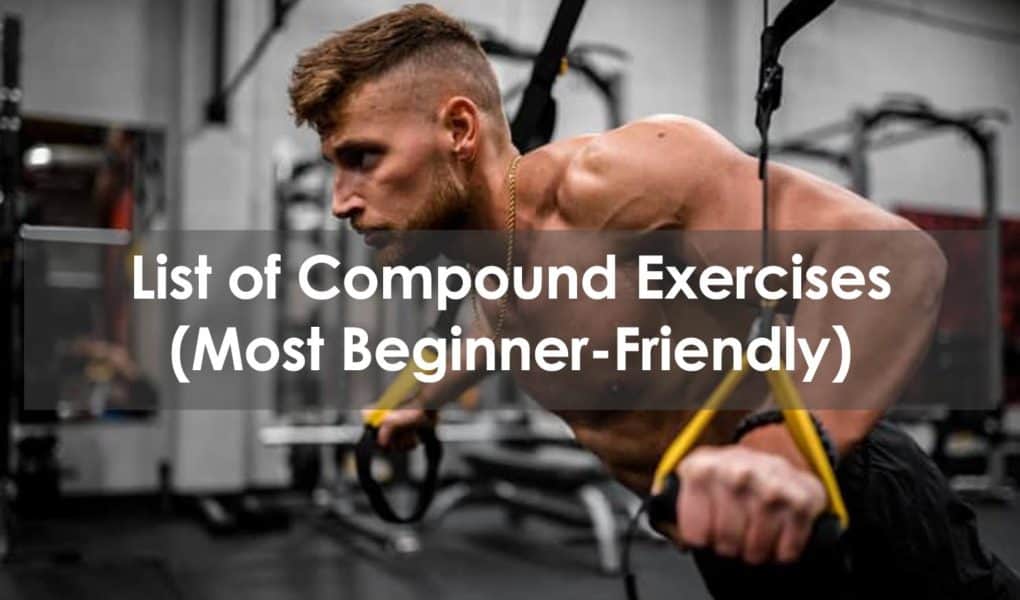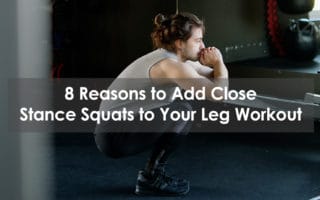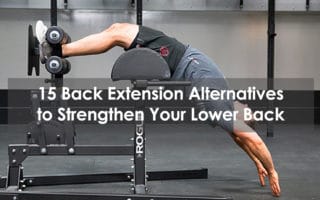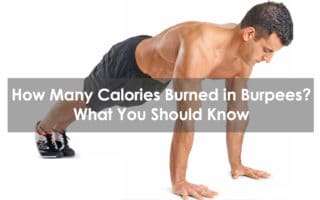Compound exercises are going to be or should be, the foundation of any program. While isolation exercises are great to hit some weaker muscles, everything is built off of compound exercises. This is especially true if you have any interest in strength training as compound exercises are vastly superior compared to isolation exercises in terms of strength.
Furthermore, contrary to popular belief, compound exercises are just as effective, if not more so, in creating muscle hypertrophy. If you are an advanced lifter, including isolation movements can be necessary. If you’re not advanced, studies have shown that compound exercises build a large number of muscles with the addition of isolation exercises providing no extra muscle growth.
This is due to the fact that compound exercises are able to train multiple muscle groups at the same time. This allows heavier loads to be used which means greater strength. It also means that you can train the same amount of muscle in less time.
This list of compound exercises will give you an idea of what you need to be doing.
List of Compound Exercises
1) Deadlift
The deadlift is one of the best compound exercises that you can do and is often referred to as the “King of Movements”. This is due to the sheer amount of muscle that is used in this compound exercise. It is as basic as a lift gets; you stand over a heavy barbell and pick it up. While simple, this movement is the best movement you can do for strength building along while packing on muscle at the same time.
Most think of the deadlift as a lower body movement mainly hitting the posterior chain. It is but so much more as it will work your hamstrings, glutes, lower back, upper back, quads, upper back, forearms, grip – literally every muscle in your body fires up during this movement.
Equipment
- Barbell
- Weights
Instructions
- Stand with the feet shoulder-width apart with the barbell over midfoot
- Push your hips back and bend over to grab the bar. You can choose to use an alternate grip or dual overhand
- Line up so that your shoulder blades are just behind the bar and your shins are vertical
- Begin the pull by driving up. Make sure to keep the bar on your shins and your back at the same angle until the bar hits your knees
- Keep your arms straight. There should be no flexion in elbow joints
- Once the bar comes above the knees, extend your hips forward and lock out
2) Back Squat
Squats and deadlifts are the two essential movements in any program. The back squat comes in a close second right behind deadlifts for muscle mass used in a compound exercise. Again, while being mainly a lower body movement, you will be forced to use your core and back to brace the weight.
The back squat is going to really your entire lower body while involving the quads a tad bit more when compared with the deadlifts. One of the great things about the back squat is you can easily scale it for a beginner lifter and use only bodyweight squats.
Equipment
- Rack
- Barbell
- Weights
Instructions
- Place the bar on the rack at a level so the bar is below your shoulders. If you need to choose, go lower than higher. DO NOT have the bar so high that you need to get on your toes!
- Find a comfortable place on your back to rest the bar. Rest the bar on your traps; NOT your neck
- Step out of the rack and have your feet a little wider than shoulder-width apart with toes pointing out. Everyone will be a little different so find a comfortable position
- You will begin lowering the weight by pushing your hips back and bending at the knees. IMPORTANT: Your hips lead the movement. This means that your hips move backwards and the knees bend to accommodate.
- Keep lowering until the top of your thighs are at least parallel. Your knees should be back, preferably behind your toes. The key is keeping a wider angle with your knee.
- Drive up. Make sure to always keep your knees over your toes.
3) Front Squat
The front squat is just a variation of the squat movement. The main difference with this exercise is that the weight will be in front of your body. Being that the weight is in front, your body will be forced to be much more vertical going down in order to support the weight. This is going to divert a lot of the stress to your quadriceps. In addition, out of all compound lifts, the front squat is one of the best exercises for core strength.
Equipment
- Rack
- Barbell
- Weights
Instructions
- Rack the barbell so that the bar is below the shoulders
- Step up to the bar so that the bar rests on your shoulders and top of your sternum in your throat (Yes, it’s uncomfortable)
- Reach back with your hands to grab the bar. This is to create a shelf for the bar to rest on
- Step out of the rack with feet approximately shoulder-width apart. Again, everyone will be different
- Sit back in a similar fashion as the front squat. The major difference is your torso will remain much more vertical
- Sit back until your thighs are parallel
- Drive upwards. Tip: As you drive up, think about driving your elbows up
4) Lunge
The lunge is a phenomenal compound exercise for the lower body. Similar to the squat, this can easily be done with bodyweight. As you advance, you can grab a pair of dumbbells or put a barbell on the back to increase the load. The lunge is great for the glutes, hams, quads, and calves. One unique aspect of the lunge is that it is a unilateral exercise. This means it trains one side at a time. While you technically train both legs each rep, your movements will be different. The lunge is also a great way to increase balance and coordination.
Equipment
- Self
- Optional: Dumbbells or Barbell and Weight
Instructions
- You can do walking or stationary
- Step one leg in front and one leg back
- Bend down by lowering the hips
- Your front shin should remain relatively vertical with your knee at about a 90-degree angle. Your back leg should be the opposite with your thigh being relatively vertical and knee at a 90-degree angle
- If you are doing walking, push forward and up. Then repeat with the opposite leg
- If doing stationary, push backwards and up. Then repeat with the opposite leg
5) Leg Press
The leg press is the first and only machine compound movement on this list. The leg press is a great exercise to use if you have some injuries with your back or just a way to load your legs with more volume. Squats are great, but they can take a lot out of you due to the sheer amount of stress placed on the body. With the leg press, you can do a similar movement but sitting down. This takes the load off of the back and allows you to focus on loading the legs.
Equipment
- Leg Press
- Weight
Instructions
- Sit down in the leg press and place your feet on the press platform
- Position your feet so that they are slightly wider than shoulder-width apart with toes pointing out
- Push up on the weight so that you can release the safety bars.
- NEVER LOCK YOUR KNEES
- Lower the weight down so that your thighs break parallel
- Push up on the weight. Keep your butt on the mat. You can grab the handlebars for support
- Reengage the safety bars when done
6) Push-Ups
Don’t think you always need equipment for a compound exercise to be great. These next few upper body body-weight movements should be on the top of your list of compound exercises regardless of the amount of equipment you have. Plus, these are great additions to add to exercises done at the home gym since you don’t need much equipment.
Push-ups are the basis for upper body pushing. This exercise is going to train your chest, shoulders, and triceps. Furthermore, a push up is basically a plank that moves up and down. This makes it a great core exercise as well.
Equipment
- Self
- Optional: Weights
Instructions
- Get into a hand plank position with your hands spread wider than shoulder-width apart and feet close together. Hint: The closer your feet are together, the more challenging the movement due to balance
- Come down by bending your elbows. IMPORTANT: Make sure your elbows come back and down. Do not let them flare out to the side
- Come down so that your chest almost touches the ground
- Push back up
- Your body should remain stiff and straight the whole movement. Do not allow your hips to sink or rise
7) Pull Ups
Pull ups are the answer to push ups. While push ups will train your pushing muscles, pull ups will train your pulling muscles. This includes all your back muscles, anterior deltoids, and biceps. Plus, one great thing about pull ups is that they are a killer workout for your core muscles.
Equipment
- Chin / pull up bar
- Optional: weights
Instructions
- Grab the bar with an overhand grip, slightly wider than shoulder-width apart
- While keeping the shoulder blades pulled back, pull your chest up to the bar
- Keep your elbows back and shoulders pulled back
8) Chin Ups
Chin ups are very similar to pull ups except that you will use a supinated grip (underhand). This will bring your elbows forward and cause more flexion in the arm. Doing so will increase the range of motion and place more stress on the biceps and traps.
Equipment
- Chin/Pull-up bar
- Optional: Weight
Instructions
- Grab the bar with an underhand grip, shoulder-width apart
- Keeping the shoulders pulled back, pull the chest up to the bar
9) Dips
If you want a big chest, start doing dips. Due to the angle of this exercise, the dip hits your chest to a very high degree. But don’t worry, you’ll still hit your tris and shoulders too! All you need for this movement is a dip station or even a tabletop or two chairs. Anything that will allow you to lift your body.
Equipment
- Dip Bars
- Optional: Weight
Instructions
- Grab the bar with a neutral grip. IMPORTANT: Grip the bar so that the meaty part below your thumb is on top of the bar
- While slightly leaning forward, lower your body down
- Keep your elbows back
- Once the triceps become parallel with the bar, push back up
10) Barbell Bench Press
The barbell bench press. Everybody has heard of International Chest Day! Perhaps the most popular exercise, the barbell bench press is perhaps the best upper body pushing exercise. As mentioned, while the dips are actually a better exercise to hit the chest muscles, the bench will develop overall strength and kill your triceps.
Equipment
- Bench
- Barbell
- Weights
Instructions
- Lay on the bench with both feet on the ground and your butt and back on the bench
- Grab the bar using the markings on the bar to ensure you’re centered
- Grab the bar with an overhand bar so that your hands are wider than shoulder-width apart
- Unrack the bar and bring the bar so that it is above the chest
- Lower the bar by bending the elbows and bringing them down at an angle to your side. DO NOT let your elbows flare straight out from your body
- Bring the bar down to your chest
- Push the bar up
11) Standing Shoulder Press
The standing shoulder press is one of the more underrated exercises on the list. The standing shoulder press is popular among Olympic weightlifters and Strongman as this movement is done quite regularly in their respective sport. Outside of those two though, you don’t see it as often when compared to others.
Well, if you’re not doing it, you need to start. While the shoulder press is another pushing movement except you are pushing vertically now above your head rather than horizontally. Any overhead press will take the chest out of the equation and put all the stress on your shoulders and triceps. However, because you are standing, you are also going to get an insane core workout.
Equipment
- Rack
- Barbell
- Weights
Instruction
- Rack the bar slightly below the shoulders
- Grab the bar with an overhand grip, slightly out side the shoulders
- Unrack the bar. KEEP the elbows underneath the bar
- Tighten your core and squeeze your butt. This is to brace while pushing
- Push the bar overhead until your elbows lockout
12) Bentover Row
The barbell bentover row is going to use our pulling muscles but in a horizontal motion. The barbell bentover row is the primary barbell compound lift of all compound exercises for the back muscles. It will work your lats, traps, delts, lower back, biceps, and even the glutes and hams
Equipment
- Barbell
- Weight
Instructions
- Grab the barbell slightly wider than shoulder-width apart
- Pick up the barbell in the same manner as the deadlift
- Slightly bend the knees to allow your torso to come forward and down
- Only push your butt back slightly. You should put emphasis on bringing the torso forward more so than pushing the hips back
- Keeping a slightly arched back, let the arms hang freely. They should hang in front of the knees
- Pull the bar up by pulling your elbows back. Keep them close to your side
- Pull the barbell into the belly button.
- Lower the weight
13) Farmer Carry
While the standing shoulder press is “one of” the most underrated exercises, the farmer carry is the most underrated and underused movement. This is a bit different as it is a moving exercise but very simple. It consists of picking up two implements and walking with them. That’s it.
While simple, this is going to work virtually every single muscle in your body.
Equipment
- Farmer Carry Implements
- If you don’t have, you can use two dumbbells or two kettlebells
Instructions
- Grab the two implements in your hands
- Stand up while holding the two implements
- Walk while carrying the two implements. Keep your core braced and shoulders pulled back
These Are All You Need
These 13 compound exercises are literally all you need to make up an amazing program for both strength and size. Whether or not if you want to build muscle, build strength, or improve body composition, you can meet all your fitness goals with these movements. Do take note though; some of these movements require a learning curve so a personal trainer would probably be a good idea. Or, there is a lot of good information on this site or on Youtube. Just remember to go slow and you’ll meet your goals.
Frequently Asked Questions
What are the big 5 compound exercises?
If you can only pick 5 compound exercises, you want to choose exercises that hit every muscle in as many different ways as possible. Therefore, I would choose
Deadlift
Squat
Bench Press
Shoulder Press
Chin-up
You can use these 5 movements and create a variety of effective programs for weight loss, strength building, or muscle building. All the major muscles will be hit along with your core and many smaller muscle groups.
How do you do compound exercises at home?
The great thing about using compound exercises as the main lifts in your workouts is that they are easily done at home. In fact, if you look at the majority of people who do workouts in home gyms, the vast majority will be doing compound exercises. This is because you relatively don’t need that much equipment to do your workouts; especially when you are beginning and aren’t lifting much weight (Plates can be expensive when you start deadlifting 500lbs!)







